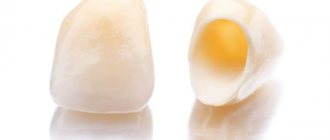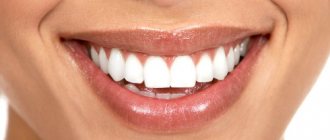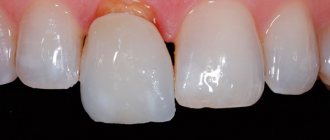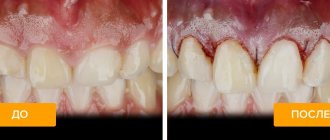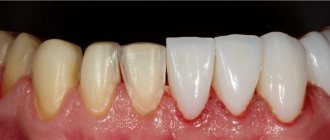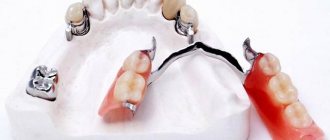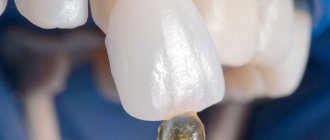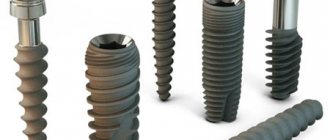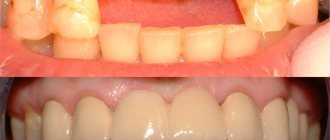Modern solutions offered by clinics allow an individual approach to each patient and selection of the optimal method of restoring teeth in case of their destruction or absence. Prosthetics allows you to restore the aesthetics of the dentition and natural chewing functions, while prolonged absence of teeth always leads to serious health consequences - it affects the bite, jaw joints, and facial appearance. Therefore, it is so important to undergo prosthetics as soon as possible and enjoy the result. But what if instead of “pleasure” you get pain after dental prosthetics?
When is pain after prosthetics normal?
The causes of pain can be different. First of all, we will reassure those who have pain after prosthetics literally on the same day or not the next day that the prosthesis, be it a crown or a bridge, was installed. In 99.9% of cases, this is a normal situation that does not promise anything bad. The anesthesia (if it was used) has stopped working, you are gradually getting used to the new prosthesis, adaptation is required. Discomfort and even a semblance of pain in such conditions is normal. But you still need to carefully monitor your feelings – and consult a specialist if:
- The pain does not go away within 7-10 days
- The pain effect increases
- The pain changes character - from aching it turns into throbbing, it occurs under certain conditions, for example, as a reaction to hot food, or worsens at night when a person takes a horizontal position.
When is a doctor needed?
If your teeth ache for longer than 7 days after grinding, you should make an appointment with your doctor. The reason for contacting a specialist may also be:
- inflammation and bleeding of gums,
- the appearance of neoplasms on the mucous membrane,
- bad breath,
- pain when chewing and brushing teeth.
The listed symptoms cannot be ignored. Even with minor discomfort, it is better to consult a doctor to exclude the development of serious diseases.
Causes of tooth pain under a crown or denture
- If you have not had root canal treatment to remove the pulp before getting a crown, pressure on the damaged nerve may cause pain.
- Patients with malocclusion and bruxism may experience pain at night from pressing on ridges or areas of the tooth that are higher than normal.
- If the denture has shifted, exposing part of the tooth, or, worse, is pressing on the dental nerve, then the slightest pressure or change in temperature can send strong pain signals.
- Teeth under a crown are also at risk for all the problems associated with regular teeth, meaning they can become infected, break, and become vulnerable if the enamel wears down. And this can cause pain.
Frequent symptoms
The problem under consideration can manifest itself in different ways. However, there is a list of common symptoms that can help determine whether you should see a doctor:
If there is an inflammatory process, the patient experiences pain when pressing on the metal-ceramic crown or when biting in this area. This may mean that the gums under the crown are inflamed. Aching pain in the area of installation - in the presence of pus in the periodontal tissue, pressure increases and pain appears.
Swollen gums indicate a large amount of pus, a serious inflammatory process. Flux is accompanied by an increase in body temperature - it rises from 38 degrees and above. The patient may also feel echoes of pain in the head, temples, eyes, ears, teeth may randomly close and knock against each other.
An unpleasant odor under the crown also appears due to the presence of pus, a fistula (a fistula tract that allows pus to escape) or a cyst.
What to do if a tooth hurts under a denture?
If toothache occurs after dentures, the first priority is to identify the cause as soon as possible and apply appropriate therapeutic measures. This problem will not resolve on its own, and any home remedies will not be effective. Therefore, do not wait and contact your dentist for professional help.
If the dentist discovers a tooth infection under the crown, he or she may recommend root canal treatment, which usually requires removal of the denture. In some cases, a hole can be drilled into the crown, allowing the dentist to access the root canal without having to remove and install another crown. This is a complex operation, but it will save you money since the removed crowns are often no longer reusable.
Materials for making crowns
Modern dental crowns are made from:
- Metal.
Metal dentures are considered obsolete due to their lack of aesthetics, but are still used because they are the cheapest option; - Metal ceramics.
A relatively inexpensive and durable option, but due to the metal base it is difficult to achieve a “healthy” whiteness of an artificial tooth; - Ceramics.
Ceramic crowns are more aesthetically pleasing than metal-ceramics, but are inferior in strength, so they are usually installed only on the front teeth; - Porcelain.
A type of ceramic crown. Porcelain dentures are indistinguishable from living teeth, since the optical properties of the material are almost identical to tooth enamel. They are also installed on the front teeth; - Zirconia.
They are made on the basis of zirconium dioxide and covered with ceramics on top. Durable, aesthetic, but quite expensive crowns.
Zirconium dentures can be installed on any tooth.
The material, contrary to popular belief, does not cause toothache, but may be the answer to the question of why the gums hurt after installing a crown. Inflammation of the mucous membrane and gums can cause an allergic reaction to the metal in a metal-containing crown. Patients with ceramic and zirconium prostheses do not encounter such problems.
Prevention of pain after dental prosthetics
As with all dental procedures, the simplest and cheapest solution is to prevent the problem from occurring in the first place.
- If you have dental crowns or bridges, you should have a dental checkup at least once every 6 months. The dentist will monitor the condition of the teeth under the dentures, since they are initially at risk.
- Hardware cleaning of bacterial plaque and possible food debris will prevent the development of infections and caries; this procedure is mandatory along with normal home oral hygiene, including brushing teeth and using dental floss.
- It is also important to monitor the integrity of the dentures - avoid hard foods and excessive loads so that the denture is not damaged or its tight fit to the stump of the supporting tooth is broken.
Don’t endure pain after dentures - contact the orthopedists at the ILATAN family dentistry closest to your home to get advice and help. Registration is available by phone +7 (495) 748-50-50.
What can cause pain after a veneer has been installed on a tooth?
To understand the origin of pain, you first need to know what technology was used to attach the veneer to the tooth.
Overlays, called veneers, are attached only to healthy (treated) teeth. If there was carious destruction and inflammation, due to which the tooth hurt even before the procedure, then it should have been eliminated. But if this was not done, then the tooth will continue to hurt and decay even under the veneer! In addition, situations occasionally arise when caries appears on a tooth after some time, while the veneer is already in place - and then the person may also be bothered by pain. Why can caries occur under installed veneers?
Before the composite or porcelain veneer takes its place on the front of the tooth, the tooth enamel is ground down (anatomically contoured). The thinning of the enamel layer itself can lead to increased sensitivity of the tooth (usually when biting and when touching cold and hot), but a correctly installed veneer serves as a kind of “shield” - a replacement for natural enamel. However, there are a number of reasons why this “shield” ceases to protect the tooth.
- If the shape or size of the veneer is chosen incorrectly, the veneer puts pressure on the gum. It is clear that all veneers are made specifically for a specific tooth of a specific patient, but sometimes, alas, mistakes are made when taking an impression or during fixation, which then turn into pain.
- The veneer has partially peeled off - that is, it has separated from the bonding cement, and food particles, drinks, saliva, etc., have begun to penetrate under it. This happens several years after installation - and then the orthodontist must decide whether it makes sense to glue this veneer or not. it's time to change it to a new one.
- A piece broke off from the veneer. This may or may not be noticeable visually (for example, if the chip appears on the side and not on the front of the tooth).
- The grinding of the enamel before installation was excessive - that is, the dentist “overdid it” and removed a larger layer of tooth enamel than necessary.
- Microcracks appeared on the tooth after some period of wearing the veneer.
All of the above reasons for tooth pain due to veneers can be attributed to the unprofessional work of dentists and orthodontists - since a correctly installed veneer should not cause pain in any case, and the tooth underneath should not be destroyed!
Probable Causes
Let's look at several factors that could cause gum problems:
- Poor preparation. Before fixing the crown, the doctor must carefully prepare the teeth: remove the nerve and conduct a thorough cleaning. If any procedure was not carried out under sterile conditions, an infection may enter the soft tissue.
- Inappropriate design. If the dental crown does not match the size of the natural tooth, sooner or later this will lead to rubbing of the mucous membrane. Constant friction will provoke an inflammatory process.
- Exceeding the service life. The average lifespan of crowns is from 5 to 10 years, depending on the material from which the product is made. After the set period, gaps form and the product no longer fits tightly to the tooth. As a result, micro food particles become clogged in the holes, which leads to rotting and inflammation.
- Inadequate dental care. If you do not follow basic hygiene rules, this can result in various complications, including gum disease.
What can you do before visiting a doctor?
Toothache often strikes a person at the most inopportune time - at night, on holidays, when he is far from a good dental clinic. The advice of our doctors will help reduce pain for a while.
- Take a pain reliever. Follow the dosage. Please note that analgesics should not be taken several hours before visiting the doctor, otherwise the local anesthesia may not work properly.
- Rinsing with warm infusions of sage, oregano, chamomile or oak bark also helps. The substances contained in these herbs have a pronounced anti-inflammatory and antimicrobial effect. To relieve the pain, you need to rinse your mouth frequently.
- Soda baths relieve pain a few minutes after the start of rinsing. Take a little warm solution into your mouth (a teaspoon per glass of water) and hold it for a couple of seconds in the area of the painful tooth, then rinse your mouth as usual.
- Massage acupuncture points. They are found in the area between the upper lip and nose, on the nail of the index finger (on the tooth side) and in the very bottom of the jaw (also on the problem side). You need to press on them for at least one minute.
- The area of inflammation should never be heated. If your cheek is swollen, apply a cold compress to it.
What complications may develop?
- Flux is the main sign of a purulent-inflammatory process in the upper part of the tooth roots. It is characterized by severe swelling of the cheek and gums, severe pain and noticeable tooth mobility.
- A fistula usually occurs as a result of an acute purulent-inflammatory process. The pus that forms in large quantities looks for a way out and, not finding it, breaks through the bone and mucous tissue and pours into the oral cavity, after which the inflammatory process subsides. This breakthrough is called a fistula. Sometimes its hole heals, but with the slightest decrease in immune defense, inflammation develops again.
- A dental cyst is a sac of fibrous tissue filled with fluid or pus. This is the last stage of chronic inflammation of the apical roots of the tooth. The cyst can be detected on an x-ray, as well as by characteristic signs - pain when pressing and periodic swelling of the gums. If the cyst is not removed immediately, then over time it will increase in size and deform the bone tissue.
